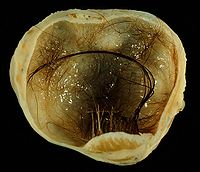
Photo from wikipedia
BACKGROUND Malignant transformation of a mature intracranial teratoma into an adenocarcinoma is an extremely rare event and portends a poor prognosis. The clinical progression, radiographic changes, histopathology, and immunohistochemistry of… Click to show full abstract
BACKGROUND Malignant transformation of a mature intracranial teratoma into an adenocarcinoma is an extremely rare event and portends a poor prognosis. The clinical progression, radiographic changes, histopathology, and immunohistochemistry of these unique cases may provide clues as to this transformation. CDX-2 is a specific and robust marker for colonic adenocarcinomas and may also be used to identify differentiation of a mature intracranial teratoma into a colonic type adenocarcinoma; this is the first case report of the use of this specific marker for an intracranial malignancy. CASE PRESENTATION We present a 55-year-old right-handed Hispanic-American woman with progressive headaches, found to have a left posterior parieto-temporal tumor with intraventricular extension. A surgical debulking was performed and the pathologic examination revealed a mature teratoma. Despite surgical resection and radiation therapies, the teratoma progressed to a malignant mature intracranial teratoma both radiographically and histologically. Histological analysis of the third specimen revealed a moderately differentiated adenocarcinoma. Tumor cells were positive for CDX-2 and CK20, and negative for CK7 and TTF-1, consistent with an enteric/colonic type adenocarcinoma, demonstrating progressive atypia and malignancy. CONCLUSIONS Malignant transformation of a mature intracranial teratoma portends a poor prognosis. The exact histopathological diagnosis may facilitate treatment of these patients. CDX-2 is a specific robust marker to identify differentiation of a mature intracranial teratoma into a colonic adenocarcinoma; this positive staining is also observed in primary colonic and other adenocarcinomas. This is the first report of the use of CDX-2 in the diagnosis of an intracranial malignancy; the triangulation of clinical progression, radiographic findings, and histopathological and IHC studies, provide clues as to this unique transformation.
Journal Title: World neurosurgery
Year Published: 2019
Link to full text (if available)
Share on Social Media: Sign Up to like & get
recommendations!